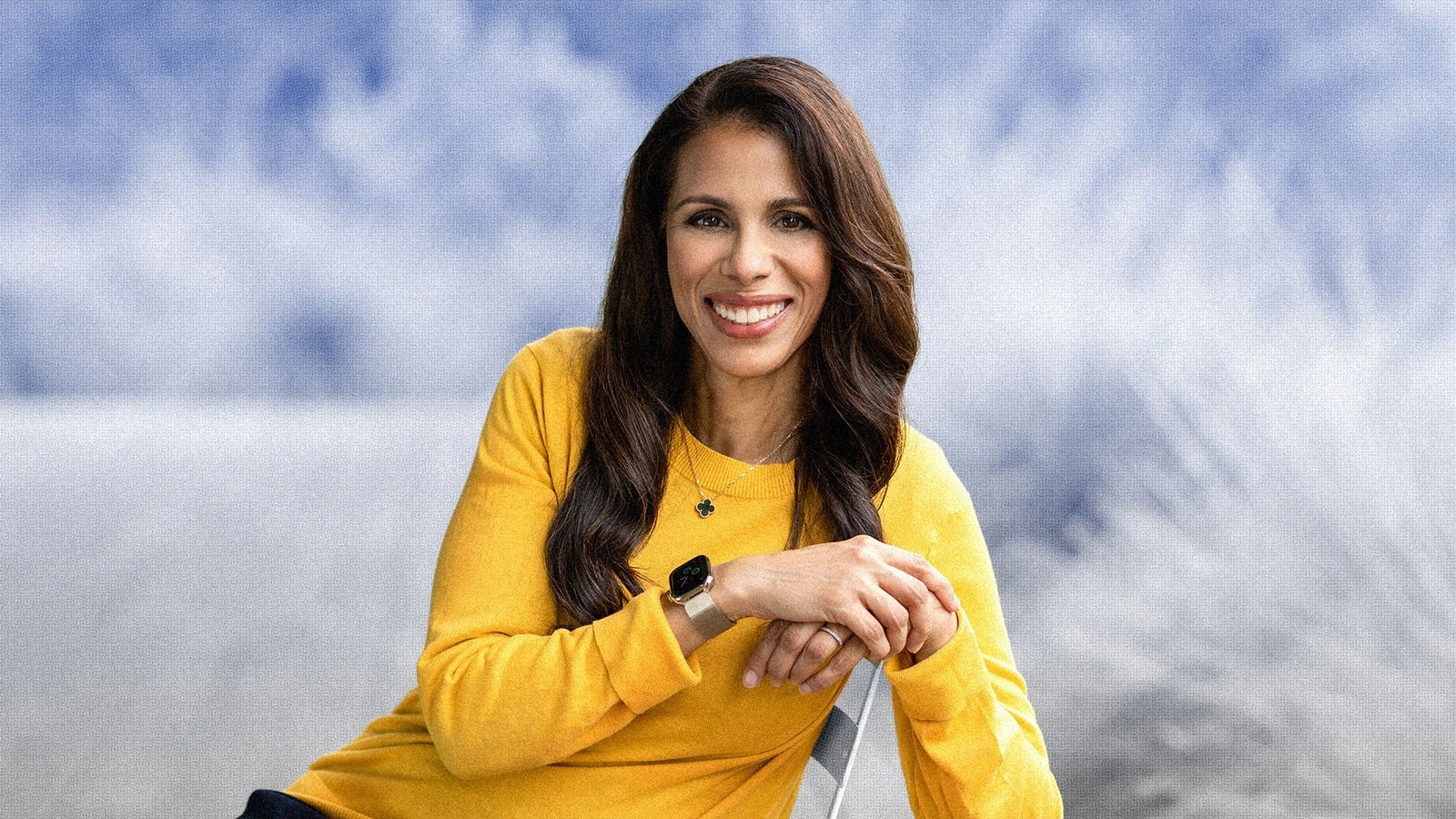Sumbul Desai
Apple and the Culture of Human Tech
By Jane Stevens

In a world increasingly shaped by the intertwining of technology and human health, few figures embody that convergence quite like Dr Sumbul Desai. As Vice President of Health at Apple Inc, she sits at the heart of one of the boldest cultural shifts of our time. The sleek devices in our pockets have become tools of self-knowledge, personal empowerment, and collective data-driven wellbeing. Her journey is hardly linear. It is layered, rooted in heritage, pivoted by crisis, and propelled by a deep commitment to bridging disparate worlds.
Sumbul Desai was born in Sweden to Indian-origin parents, her mother hailing from Delhi and her father from Uttar Pradesh. She grew up oscillating between the global and the intimate. “Whenever you go back, you really go back to your roots and it grounds you,” she once reflected. Her upbringing is steeped in the kind of duality many migrant families know, loyalty to tradition, and yet the ambition to chart new terrains.
Her parents, like many in their generation, held firm beliefs about what a “successful” child should be, doctor or engineer. In one telling anecdote, Desai says, “My parents wanted me to be either a doctor or an engineer.” It was, she implies, the safest path. But she didn’t always want safe. She longed for something broader, journalism, media, communication. That longing took her into the world of newsrooms and studios.
Her first degree, unexpectedly, was in computer science with a minor in communications, but those choices were still shaped by her father’s insistence on a “respectable” major. What is telling is how these early steps, media, business strategy, and engineering, were not detours but building blocks of what was to come.
Then came the crucible. In August 2001, while visiting family in New York, her mother suffered a massive hemorrhagic stroke. Suddenly, the world shifted. Desai watched helplessly in an ICU as the hospital became part of the story of her mother’s survival, but also of her own awakening. That moment redirected her trajectory from media to medicine.
She realised that her hunger for impact, her desire to work with people, not just communicate about them, needed the rigour of science and care. She entered medical school, trained in internal medicine, and gradually moved into digital-health innovation at Stanford Medicine. Before joining Apple, she served as Vice Chair of Strategy and Innovation at Stanford, Associate Chief Medical Officer at Stanford Healthcare, and Clinical Associate Professor in the Department of Medicine.

What’s remarkable is that rather than view the jump from media to medicine as a break, Desai sees it as continuity. The “through-line,” she says, is empowerment. “How do you have impact, and how do you make good in the world?”
In 2017, Apple hired Desai to lead its health initiatives. The hire came at a pivotal moment. Wearable devices, sensors, and smartphones were poised to become not just lifestyle accessories but portals into our physiology. Under her leadership, Apple began betting that health tech would be more than tracking steps. Rather, it would be about insights, empowerment, and relationship building.
She often describes Apple’s health work as “like an orchestra in a symphony,” where engineering, design, regulatory expertise, research, and the actual human patient all have to perform together. That orchestration is cultural in the richest sense. It asks engineers to think like ethicists, doctors to think like product designers, and users to think of data as personal storylines.
For Apple, this means features like the ECG app, irregular heart rhythm notifications, blood-oxygen monitoring in the Apple Watch Series 6, hearing-health features in AirPods Pro, and sleep tracking, among many others. But beyond features, it’s about agency. In Desai’s words, it is about “empowering individuals to feel they are in control of their health journey,” rather than being passive recipients of medical data.
It is here that culture comes into play. Apple’s “own your device, own your data” stance is not just technological, it is ethical, psychological, even spiritual. It merges Eastern ideas of self-care and Western models of quantified self-tracking. Desai, with her background bridging media, medicine, and technology, embodies this merging.
In a corporate arena still dominated by the few, Desai stands out not just for her role but for who she is, a Muslim woman of Indian descent leading at one of the world’s most influential tech companies. She reflects on this with characteristic humility and insight. “The one thing that I’m blessed with is that as a woman, and especially as a Muslim woman, my parents always felt that I should be independent.”
Her identity informs her values, independence, integrity, and service. And her leadership style reflects it, less hierarchical brilliance, more orchestral harmony. She invites disciplines to collaborate rather than dominate. She invites individuals to understand rather than outsource their wellbeing.
In an interview she noted, “The ability to communicate is really critical. You want to be able to take very complex topics and figure out how to distill them down in a simple way.” That communication draws from her media days, reminding us that technology alone does not provoke culture, stories do.
Let’s pause and consider the cultural moment Desai inhabits. Think of a person’s wristwatch not just telling the time but signalling an alert, “Your rhythm is irregular.” Think of an iPhone not just holding apps, but holding a record of your walking, your breathing, your daylight exposure, your moods. In that shift lies a recalibration of everyday life, how we care for ourselves, how we talk with our doctors, how we share our bodies, in encrypted, private form, with platforms and with each other.
Desai and Apple are part of this reshaping of culture. For many people, their first experience with medical insight comes from a wearable gadget, not a specialist. The rituals of measuring steps, of being notified of breathing stability, of logging mood, all reflect a flattened boundary between tech lifestyle and health practice.
In this sense, Desai sees her job not simply as launching features but elevating awareness. “We’re excited to introduce features that offer valuable new insights. These insights help support users in their daily decisions and offer more informed conversations with their doctors.” That is a cultural project, shifting health from reactive to proactive and from isolated to everyday.
Of course, the journey is not without its tensions. The very ambition that Apple carries in health tech, from inside-clinic research to device-based insights, has cautious watchers. For all the optimism, Desai acknowledges that “as advanced as technology is, when it comes to technology and healthcare, we are still very early in our journey.”
In cultural terms, this means negotiating privacy concerns, regulatory expectations, unequal access, and the danger of over-promising. Desai emphasises that Apple’s devices are “never meant for diagnosis” but for screening or additional information. The gap between possibility and reality remains.
Yet that tension is part of the cultural moment, the interplay of hope and caution, of user enthusiasm and medical integrity, of rapid innovation and slow-moving regulation. Desai stands in that liminal space.
While she leads one of the most advanced health-tech operations in the world, Desai retains a grounded, human-centred perspective. In one interview, she shared how she begins her day, waking early, taking twenty minutes for prayer or meditation, then coffee and exercise. Amid the demands of global corporate life, she still draws from her personal culture, morning rituals, silence, reflection.
It’s noteworthy how she links this personal grounding to her professional mission. “Giving yourself space between the time you finish work and you go home is really beneficial.” Such remarks remind us that cultural leadership in tech is not just about innovating devices, it’s about modelling habits, values, and the integration of self-care into productivity.
Under Desai’s leadership, Apple is turning its gaze to newer territories, mental health and vision health. In recent announcements, she emphasised these two as “next frontiers” for innovation. In iOS 17, watchOS 10, and related updates, Apple introduced features for mood logging, daylight exposure tracking for myopia risk reduction, and richer interventions in emotional wellbeing. These moves reflect culture’s evolving expectations, health is not just about physical metrics but psychological, emotional, and environmental ones.
And importantly, they signal that health tech is no longer niche. It is mainstream. The wristwatch becomes a sensor for mood. The smartphone becomes a tracker for daylight. In this way, the devices we carry carry us into a new relationship with our own bodies, habits, and rhythms.
Desai frames this succinctly, “Our goal is to empower people to take charge of their own health journey.” That phrase captures the cultural shift, from doctor-directed to self-informed, from episodic visits to continuous engagement, from opaque data to meaningful insight.
At its heart, the work of Sumbul Desai is cultural work. Technology is the medium, but the transformation is social. She represents belonging and representation, a woman of Indian origin, a doctor turned executive in Silicon Valley, offering a model of cross-cultural leadership. She reflects the integration of spheres, media, medicine, and technology becoming one narrative, one career. She embodies shifting agency, wearables showing that health is not only about the clinic, but about our daily rhythms, choices, and behaviours. She carries ethics and empowerment, promoting ownership of data, privacy, and user control, and she bridges the global and the local, rooted in Indian heritage, educated in the US, and working at a global company.
In a design-rich, thought-provoking style, one might imagine locating Desai’s story among images of Cupertino labs, hospital corridors, wearable interfaces, and portraits of her reflecting in early morning light. That is appropriate because the story is itself one of layering, heritage over innovation, self-care over performance, data over mystery, design over engineering.
If you ask Sumbul Desai what’s the red thread in her journey, she would probably say, “All of those stops you are going to make are going to help you with your ultimate role.” It is a statement of faith in the non-linear, in the pivot, in the mosaic rather than the straight line. It is cultural in its embrace of fluidity rather than rigid path.
In the era where our devices track sleep and our wrists measure oxygen, her role is not merely to manage tech, it is to shape culture. A culture where we ask not “What does my gadget tell me?” but “What is my gadget helping me understand about me?” Where health becomes less about treating disease and more about sustaining life, day by day, bit by bit.
Sumbul Desai’s story is one of possibility. And for a world that’s hungry for leaders who bridge meaning and mechanics, design and data, tradition and innovation, she is quietly proving that where one grew up, and what one once wanted as a teenager, both matter. Because in the end, culture is the confluence of past, present, and future, and so too is health.


